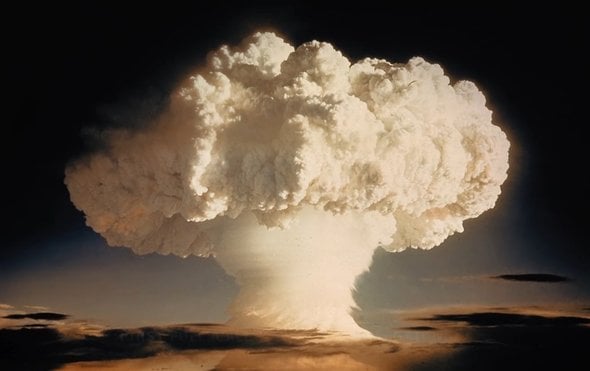
In the image below, you can see the mushroom cloud from the explosion of ivy Mike in 1952, the first thermonuclear fusion bomb ever exploded. In the process of fusion and fission of nuclei is allocated a colossal amount of energy, thanks to which we are to shiver fear of nuclear weapons. Recently it became known that physicists have discovered an even more powerful energy subatomic reactions than fusion, which occurs at the scale of quarks. Fortunately, she didn’t seem particularly suited to create weapons.
When a couple of physicists announced the discovery of a powerful subatomic process, it became known that the scientists wanted to classify the opening as it could be too dangerous for the public.

Was there an explosion? Scientists have shown that two tiny particles known as bottom quarks, could theoretically merge in a powerful flash. The result: a large sub-atomic particle, known as a nucleon, and a lot of energy spill out into the universe. This “quark explosion” could become even more powerful subatomic analogue of the thermonuclear reactions that occur in the nuclei of the hydrogen bomb.
Quarks are tiny particles that cling to each other, forming neutrons and protons inside of atoms. They come in six versions, or “flavors”: top, bottom, charmed, strange, the top one (true) and the bottom (lovely).
Energy events at the subatomic level are measured in megaelectronvolts (MeV), and when the two bottom quark merge, physicists found that they give a whopping 138 MeV. It is about eight times stronger than a single nuclear fusion that occurs in hydrogen bombs (with full bomb consists of billions of such events). Hydrogen bombs are synthesized together in the tiny nucleus of hydrogen — deuterium and tritium — with the formation of helium nuclei and a massive explosion. But each of the separate reactions within a bomb only releases 18 MeV, according to Nuclear Weapon Archive. It is much smaller than in the synthesis of bottom quarks — 138 MeV.
“I have to admit, when I first realized that such a reaction is possible, I was scared,” says one of the scientists Marek Karliner from tel Aviv University in Israel. “Fortunately, it was not so scary.”
With all the power of the fusion reactions, the individual reaction is not so dangerous. Hydrogen bombs derive their awesome power of chain reactions cascade of mergers of multiple cores simultaneously.
Karliner and Jonathan Rosner University of Chicago determined that such a chain reaction would be impossible with participation of charming quarks, and before the publication shared their concerns with colleagues who agreed with their conclusion.
“If I even for a microsecond thought that such a process may be military applications, I would not have written about it,” says Carliner.
To trigger a chain reaction in producers of nuclear bombs needed an impressive inventory of particles. An important property of charming quarks is that they cannot be collected in the inventory: they cease to exist after one picosecond after the creation, and during this time, the light can pass only half the length of the granules of salt. After this time, the beauty quark decays into a more common and less energetic type of subatomic particle — the top quark.
You can create a separate reaction for the synthesis of charming quarks in kilometer tunnel of a particle accelerator, scientists said. But even inside the accelerator is impossible to accumulate a large enough mass of the quarks to do any damage. Therefore, to worry about.
The opening is unbelievable, because it was the first theoretical proof that subatomic particles can be synthesized with the production of energy, says Karliner. This is a brand new area in the physics of the smallest particles, which was opened by the experiment on the Large hadron Collider at CERN.
That’s how physicists came to this discovery.
At CERN the particles race around the 27-kilometer ring underground at the speed of light and then collide. The scientists then used powerful computers to sift through data from these collisions, and these data sometimes there are strange particles. In June, for example, data show “twice charmed” a baryon, or bulky cousin of the neutron and proton, consisting of two cousins “pretty” and “top” quarks — “charmed” quarks.
Charmed quarks are very heavy compared to the more common top and bottom quarks, constituents of protons and neutrons. And when heavy particles are associated with each other, they convert a big chunk of its mass into energy, and in some cases leave the energy that escapes into the universe.
Karliner and Rosner found that when two charmed quark coalesce the particles are bound with an energy of about 130 MeV and 12 MeV emit the remaining energy. It is the fusion of charmed quarks was the first reaction of the particles of this scale, which has been emitted energy. She became the main thesis of a new study published November 1 in the journal Nature.
More energetic merger of two charming quarks that are bound with an energy of 280 MeV and emit 138 MeV in the merger, became the second and more powerful of the two discovered reactions. As long as they remain theoretical, and unproven in experimental conditions. The next step will soon follow. Karliner hoped that the first experiments demonstrating this reaction will be conducted at CERN during the next few years.
Scientists wanted to classify the discovery of the “quark fusion”
Ilya Hel